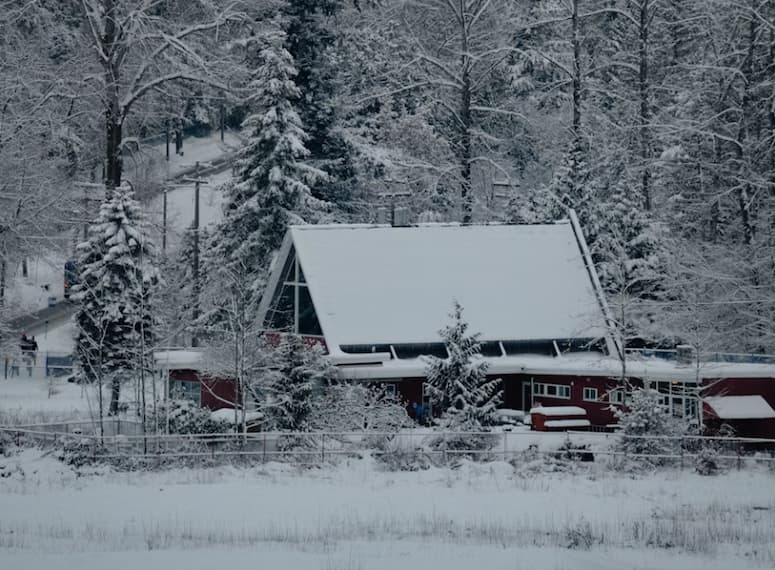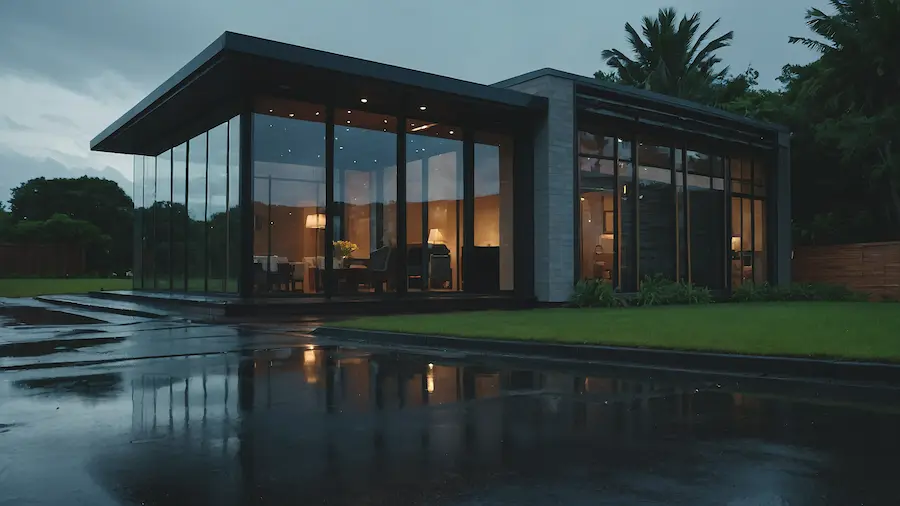Winter-Proofing Your Coastal Home: Campbell River's Essential Guide
Prepare your Vancouver Island home for winter's Pacific storms. Mike Sinclair's comprehensive guide to protecting your property from Campbell River's wet, windy winter months.

Mike Sinclair
Paint it Right Team

When October arrives in Campbell River, experienced homeowners know what’s coming: six months of Pacific storms, driving rain, and the full force of coastal weather. After 15 years helping Vancouver Island residents protect their homes, I’ve learned that proper winter preparation can mean the difference between minor maintenance and major repairs come spring.
Understanding Campbell River’s Winter Weather
Our winters are unique in Canada - not the coldest, but potentially the most damaging to homes:
The Numbers Tell the Story
- Rainfall: 200-300mm per month (November-February)
- Wind: Regular storms with 70-90 km/h gusts
- Storm events: 10-15 major systems per season
- Temperature: Rarely below freezing, but frequent freeze-thaw cycles
- Humidity: 85-95% average
This combination creates perfect conditions for moisture infiltration, wind damage, and accelerated wear on exterior surfaces.
The Pacific Storm Season Timeline
October: The Warning Month
Early storms arrive, giving us a preview of what’s ahead. This is your last chance for major preparations.
November-January: Peak Storm Season
The infamous “Pineapple Express” and Arctic outflow events. Expect everything from torrential rain to occasional snow.
February-March: Late Season Surprises
Don’t let your guard down - some of our worst storms arrive when we think winter’s ending.
Critical Exterior Checkpoints
1. Roof and Gutter Systems
Your first line of defense needs thorough attention:
Roof Inspection:
- Missing or damaged shingles
- Moss accumulation (common problem)
- Flashing integrity
- Vent boot conditions
- Skylight seals
Gutter Essentials:
- Complete cleaning (2-3 times minimum)
- Downspout flow testing
- Bracket security
- Seal any leaks
- Install gutter guards
Campbell River Specific: Properties near forests (Rockland, Beaver Lodge Lands) need more frequent gutter cleaning due to needle drop.
2. Exterior Paint and Siding
Paint isn’t just aesthetic - it’s protection:
Inspection Points:
- Peeling or blistering paint
- Exposed wood
- Caulk joint failures
- Trim separation
- Efflorescence on masonry
Quick Fixes Before Winter:
- Touch up exposed areas
- Re-caulk critical joints
- Prime bare wood
- Seal end grains
3. Windows and Doors
Where warm meets cold, problems develop:
Check and Repair:
- Weather stripping condition
- Caulking integrity
- Drainage channels
- Operating mechanisms
- Storm window installation
Energy Savings Bonus: Proper sealing can reduce heating costs by 15-25% during Campbell River’s damp winters.
4. Foundation and Drainage
Water management is crucial:
Essential Tasks:
- Clear perimeter drains
- Check sump pumps
- Seal foundation cracks
- Ensure positive grading
- Clean catch basins
Problem Areas in Campbell River:
- Clay soil expansion
- High water tables
- Hillside properties (Upper Rockland)
- Proximity to creeks
Wind Protection Strategies
Understanding Wind Patterns
Campbell River’s position creates unique wind challenges:
- Southeasters: Bring heavy rain
- Arctic Outflows: Cold, dry, damaging
- Storm surges: Affect waterfront properties
Securing Your Property
Permanent Improvements:
- Install storm shutters
- Upgrade to impact windows
- Reinforce garage doors
- Secure roof edges
Seasonal Preparations:
- Trim tree branches (especially Douglas Firs)
- Secure outdoor furniture
- Remove hanging planters
- Anchor garbage bins
Special Considerations for Waterfront
Properties along Discovery Passage face additional challenges:
- Salt spray intensifies
- Wave action during storms
- Floating debris risks
- Erosion concerns
Preventing Moisture Damage
The Hidden Enemy
Our mild, wet winters create perfect conditions for:
- Wood rot
- Mold growth
- Paint failure
- Insulation damage
Interior Protection
Ventilation Is Key:
- Run bathroom fans longer
- Use kitchen exhaust hoods
- Consider a dehumidifier
- Maintain HRV systems
Monitor Problem Areas:
- Basements and crawlspaces
- Attics
- Behind furniture on exterior walls
- Window condensation
Emergency Preparedness
Campbell River’s Winter Storm Kit
Beyond standard emergency supplies:
- Tarps and plastic sheeting
- Sandbags (for properties near water)
- Battery-powered radio (marine weather)
- Chainsaw (for fallen trees)
- Generator (power outages common)
- Water pumps
Important Contacts
- BC Hydro: 1-888-POWERON
- City of Campbell River: 250-286-5700
- Emergency Services: 911
- Local contractors (pre-arrange)
Plant and Landscape Protection
Native Plants vs. Exotic
Vancouver Island natives handle winter better:
- Salal, Oregon Grape, Sword Ferns
- Shore Pine, Western Red Cedar
- Pacific Dogwood (protect young trees)
Winter Garden Prep
- Mulch sensitive plants
- Wrap exotic trees
- Secure climbing plants
- Prune strategically
- Clear drain rocks
The Paint Protection Plan
Why Paint Matters in Winter
Quality exterior paint provides:
- Moisture barrier
- UV protection (yes, even in winter)
- Substrate preservation
- Aesthetic maintenance
Winter Touch-Up Strategy
When weather permits:
- Address failed caulking immediately
- Touch up exposed wood
- Seal trim ends
- Protect thresholds
Products That Perform
For winter touch-ups, use:
- Fast-drying primers
- Elastomeric caulks
- Moisture-cure products
- Mildew-resistant formulas
Month-by-Month Action Plan
September
- Complete exterior inspection
- Schedule major repairs
- Order materials
- Book contractors
October
- Final painting projects
- Gutter cleaning round 1
- Tree trimming
- Secure outdoor items
November
- Install storm windows
- Weatherstripping check
- Gutter cleaning round 2
- Monitor weather forecasts
December-February
- Regular inspections after storms
- Document any damage
- Emergency repairs only
- Plan spring projects
March
- Assess winter damage
- Begin repair planning
- First spring cleaning
- Book painting season
Cost-Benefit Analysis
Prevention Investment
- Fall inspection: $200-500
- Minor repairs: $500-2,000
- Gutter cleaning: $200-400
- Tree trimming: $300-1,000 Total: $1,200-3,900
Potential Repair Costs
- Roof repairs: $2,000-15,000
- Siding replacement: $10,000-30,000
- Foundation repairs: $5,000-25,000
- Mold remediation: $3,000-10,000 Total risk: $20,000-80,000
Local Success Stories
Case 1: Willow Point Waterfront
Challenge: Severe wind exposure, salt spray Solution: Annual maintenance program, strategic windbreaks Result: 12 years without major repairs
Case 2: Rockland Hillside Home
Challenge: Water drainage, tree hazards Solution: Improved drainage, regular tree maintenance Result: Survived multiple atmospheric rivers
Case 3: Downtown Heritage Building
Challenge: Aging structure, multiple storm exposures Solution: Comprehensive restoration, modern protection Result: Preserved character with improved resilience
When to Call Professionals
Don’t wait for emergencies:
Red Flags:
- Water stains appearing
- Drafts increasing
- Paint failing rapidly
- Gutters overflowing
- Foundation water
Benefits of Professional Assessment:
- Trained eye for problems
- Proper equipment
- Safety expertise
- Warranty protection
- Insurance documentation
Climate Change Adaptation
Recent winters show concerning trends:
- More intense storms
- Increased rainfall
- Stronger winds
- Rapid weather changes
Future-Proofing Strategies:
- Upgrade to superior materials
- Improve drainage capacity
- Consider rain screens
- Plant windbreaks
- Build resilience
Your Winter Preparation Checklist
Exterior:
- Roof and gutter inspection
- Paint and caulk check
- Window/door sealing
- Foundation drainage
- Tree assessment
- Secure loose items
Interior:
- Ventilation systems
- Emergency supplies
- Heating maintenance
- Moisture monitoring
- Insurance review
Documentation:
- Photo inventory
- Contractor contacts
- Maintenance records
- Insurance policies
- Emergency plan
The Bottom Line
Winter on Vancouver Island isn’t about surviving snow and ice - it’s about managing water, wind, and time. Every September day spent preparing saves multiple March days repairing. The Pacific Ocean gives us incredible beauty and lifestyle, but demands respect and preparation in return.
At Paint it Right, we’ve weathered 15 Campbell River winters, learning from each storm what works and what doesn’t. We understand that protecting your home isn’t just about maintaining property value - it’s about preserving your family’s comfort and security through the challenging months ahead.
Don’t let another winter catch you unprepared. Contact us today for a comprehensive winter readiness assessment. Together, we’ll ensure your coastal home stands strong against whatever the Pacific throws our way.
Remember: on Vancouver Island, winter preparation isn’t just maintenance - it’s survival. Let’s make sure your home is ready.

